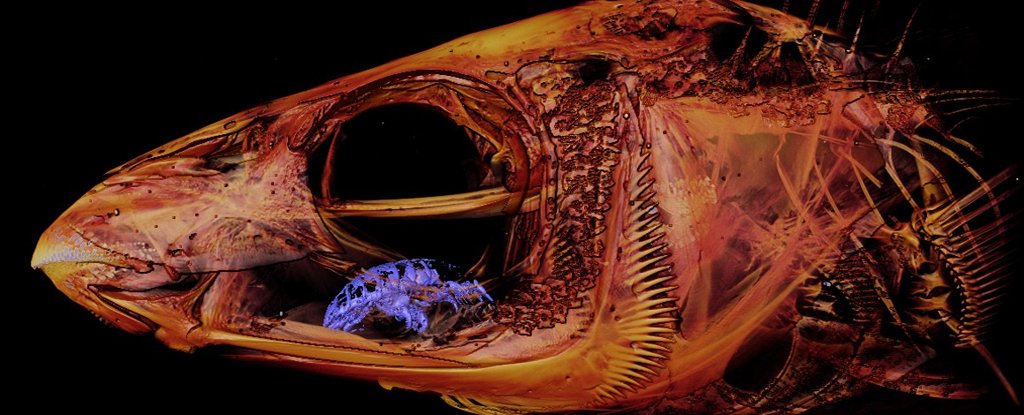
Fans of nature's horror shows will no doubt be familiar with those tongue-eating parasites known for tapping into the blood supply of fish, sometimes attaching themselves to the tongue, causing it to die and eventually replacing it altogether.
Normally, we get to experience these finds as unnerving photos of isopods peeking out the mouth of a hapless fish. But the latest discovery brings an entirely new level of detail.
Biologist Kory Evans from Rice University in Texas stumbled across a tongue-eating isopod in a completely unexpected way, and shared his surprise on his Twitter account.
Mondays aren't usually this eventful. I found a tongue-eating isopod (purple) in one of our wrasse scans this morning while digitizing it. These parasites attach themselves to the tongues of fishes and effectively become the new tongue...horrifying #backdatwrasseup pic.twitter.com/axlraUrh8W
— Kory Evans PhD (@Sternarchella) August 10, 2020
His digitised scans make up an image bank for a study on the evolution of wrasses, with a particular focus on factors that influence the shapes of their skulls.
Noticing what he initially assumed to be a mouthful of bug in the mouth of a herring cale (Olisthops cyanomelas), Evans zoomed in for a closer look.
As reported by CNN's Scottie Andrew, Evans recalled thinking, "This shouldn't eat bugs, this eats seaweed, so what's going on here?"
We can only guess at what kind of scientific value this image might have for piscatorial parasitologists, but given what little we know of such aquatic vampires, we hope the picture might at least spark a bit of interest in research.
One Twitter user even took Evans's data and produced a three-dimensional tour of the poor fish and its terrifying companion.
And here it is! @Sternarchella 's beautiful scan explored in @syGlassVR 😍😍🤩 super fun to play with this data! pic.twitter.com/Z4wjwxJubI
— Michael Morehead (@michael_syglass) August 13, 2020
While we don't know which species took hold of this unlucky fish, one of the best known tongue-eating parasites around the internet is Cymothoa exigua, a species of arthropod found in the surface waters from the Gulf of California off North America's west coast down to the coast off Ecuador.
Juvenile isopods are known to grab hold of the gill tissue of suitable host fish as they filter through, where they adopt male traits as they mature. From there, isopods that develop further into females make their way into the mouth where they use their claws to renovate the plumbing, clipping into the blood vessels that feed the tongue and causing the tissue to blacken and eventually die off.
There the parasite remains, slurping up fish blood like the devil's spawn it is, ready to mate and nurture its young in the safety of its house of sushi until its nutrient supply dwindles to a trickle.
Meanwhile, it can function (if you can call it that) as a rather clumsy kind of pseudo-tongue for its host. Once they part ways, mother isopod is either consumed or simply falls away, while the fish struggles to survive tongueless.
As with most parasites, tongue-eating isopods tend to specialise in their choice of host. We don't yet know much about the one in Evans's scan, but it could become the start of a new side project.
We're willing to bet he'll be doing his work with a colourised picture of one of nature's most nightmarish beasts staring down on him.
Sure beats any horror movie poster we can imagine.
"fish" - Google News
August 14, 2020 at 10:09AM
https://ift.tt/2DHDoCt
Biologist Accidentally Finds Nightmare Fish Parasite While Digitising Scans - ScienceAlert
"fish" - Google News
https://ift.tt/35JkYuc
https://ift.tt/3feFffJ
Bagikan Berita Ini















0 Response to "Biologist Accidentally Finds Nightmare Fish Parasite While Digitising Scans - ScienceAlert"
Post a Comment